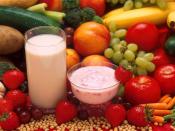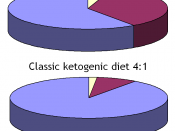Many Americans can tell you what components make up their food. Looking at a nutrition facts label, they can tell you the content of fat, carbohydrate, and protein in the foods they eat. Many participate in low carbohydrate dieting, one of the most popular diets around. Others have opted for the United States Department of Agriculture's low fat diet, but neither understands the chemistry of the body or may have misinformation about these compounds. Not many Americans can tell you confidently what a fat, carbohydrate, or protein is chemically or how it works in the body. It can be confusing for the 65% of United States adults who are considered obese and everyone else to figure out what constitutes proper nutrition (Last & Wilson, 2006).
All three components share the qualities of being organic compounds, but their structures and functions are quite different. All three contain carbon, oxygen, and hydrogen.
Carbon is an element common to all organic substances. This paper is intended to explain the differences in the basic organic compounds we eat and see learn how the body uses each one.
Fats
Everyone dreads fat, we eat reduced fat foods, go on low-fat diets, anything to get rid of fat. Unfortunately, the answer is not to simply eliminate fat from your diet to eliminate it from your body. Technically, a fat is a "lipid with a glycerol head and one, two, or three fatty acid tails" (Starr, 2000). Looking at the nutrition facts on a food label, fats are often broken down into saturated, unsaturated, and occasionally polyunsaturated. These differences refer to the number of hydrogen atoms attached to the carbon backbone of a fatty acid tail. A fatty acid with only single bonds is considered saturated. Unsaturated means there is at least one opening, and polyunsaturated...



A good introduction...
To the nutrients fats, proteins and carbs give us, their pros and cons, and their common uses today. I would not, however, call this a college-level essay. If you're in your sophomore year, you'd expect something more in-depth and complicated than this
2 out of 2 people found this comment useful.